
Titanite, or sphene (from Ancient Greek σφηνώ (sphēnṓ) 'wedge'), is a calcium titanium nesosilicate mineral, CaTiSiO5. Trace impurities of iron and aluminium are typically present. Also commonly present are rare earth metals including cerium and yttrium; calcium may be partly replaced by thorium.
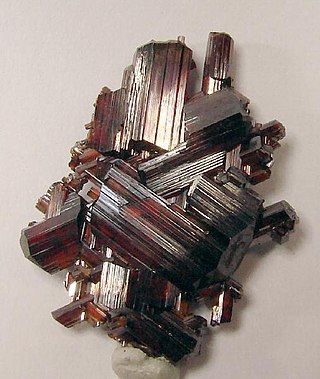
Rutile is an oxide mineral composed of titanium dioxide (TiO2), the most common natural form of TiO2. Rarer polymorphs of TiO2 are known, including anatase, akaogiite, and brookite.

Bytownite is a calcium rich member of the plagioclase solid solution series of feldspar minerals with composition between anorthite and labradorite. It is usually defined as having between 70 and 90%An. Like others of the series, bytownite forms grey to white triclinic crystals commonly exhibiting the typical plagioclase twinning and associated fine striations.

Brookite is the orthorhombic variant of titanium dioxide (TiO2), which occurs in four known natural polymorphic forms (minerals with the same composition but different structure). The other three of these forms are akaogiite (monoclinic), anatase (tetragonal) and rutile (tetragonal). Brookite is rare compared to anatase and rutile and, like these forms, it exhibits photocatalytic activity. Brookite also has a larger cell volume than either anatase or rutile, with 8 TiO2 groups per unit cell, compared with 4 for anatase and 2 for rutile. Iron (Fe), tantalum (Ta) and niobium (Nb) are common impurities in brookite.

Sillimanite or fibrolite is an aluminosilicate mineral with the chemical formula Al2SiO5. Sillimanite is named after the American chemist Benjamin Silliman (1779–1864). It was first described in 1824 for an occurrence in Chester, Connecticut.
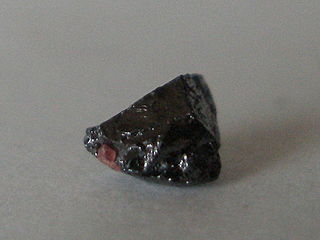
Armalcolite is a titanium-rich mineral with the chemical formula (Mg,Fe2+)Ti2O5. It was first found at Tranquility Base on the Moon in 1969 during the Apollo 11 mission, and is named for Armstrong, Aldrin and Collins, the three Apollo 11 astronauts. Together with tranquillityite and pyroxferroite, it is one of three new minerals that were discovered on the Moon. Armalcolite was later identified at various locations on Earth and has been synthesized in the laboratory. (Tranquillityite and pyroxferroite were also later found at various locations on Earth). The synthesis requires low pressures, high temperatures and rapid quenching from about 1,000 °C to the ambient temperature. Armalcolite breaks down to a mixture of magnesium-rich ilmenite and rutile at temperatures below 1,000 °C, but the conversion slows down with cooling. Because of this quenching requirement, armalcolite is relatively rare and is usually found in association with ilmenite and rutile, among other minerals.
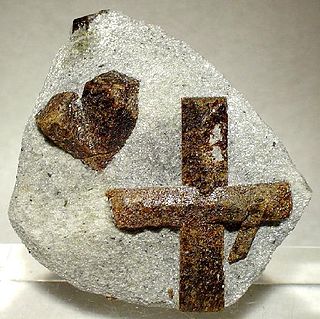
Staurolite is a reddish brown to black, mostly opaque, nesosilicate mineral with a white streak. It crystallizes in the monoclinic crystal system, has a Mohs hardness of 7 to 7.5 and the chemical formula: Fe2+2Al9O6(SiO4)4(O,OH)2. Magnesium, zinc and manganese substitute in the iron site and trivalent iron can substitute for aluminium.
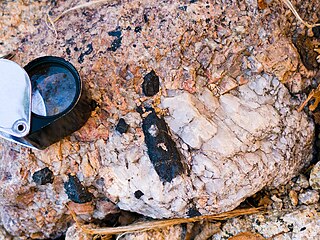
Riebeckite is a sodium-rich member of the amphibole group of silicate minerals, chemical formula Na2(Fe2+3Fe3+2)Si8O22(OH)2. It forms a solid solution series with magnesioriebeckite. It crystallizes in the monoclinic system, usually as long prismatic crystals showing a diamond-shaped cross section, but also in fibrous, bladed, acicular, columnar, and radiating forms. Its Mohs hardness is 5.0–6.0, and its specific gravity is 3.0–3.4. Cleavage is perfect, two directions in the shape of a diamond; fracture is uneven, splintery. It is often translucent to nearly opaque.
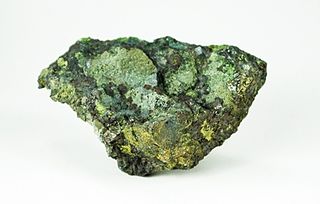
Trevorite is a rare nickel iron oxide mineral belonging to the spinel group. It has the chemical formula NiFe3+2O4. It is a black mineral with the typical spinel properties of crystallising in the cubic system, black streaked, infusible and insoluble in most acids.
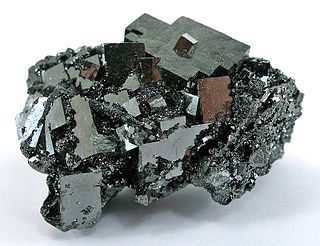
Bixbyite is a manganese iron oxide mineral with chemical formula: (Mn,Fe)2O3. The iron/manganese ratio is quite variable and many specimens have almost no iron. It is a metallic dark black with a Mohs hardness of 6.0 – 6.5. It is a somewhat rare mineral sought after by collectors as it typically forms euhedral isometric crystals exhibiting various cubes, octahedra, and dodecahedra.

Aenigmatite, also known as cossyrite after Cossyra, the ancient name of Pantelleria, is a sodium, iron, titanium inosilicate mineral. The chemical formula is Na2Fe2+5TiSi6O20 and its structure consists of single tetrahedral chains with a repeat unit of four and complex side branches. It forms brown to black triclinic lamellar crystals. It has Mohs hardness of 5.5 to 6 and specific gravity of 3.74 to 3.85. Aenigmatite forms a solid-solution series with wilkinsonite, Na2Fe2+4Fe3+2Si6O20.
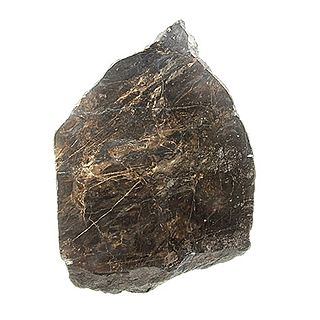
Galaxite, also known as 'mangan-spinel' is an isometric mineral belonging to the spinel group of oxides with the ideal chemical formula Mn2+Al2O4.

Chlorargyrite is the mineral form of silver chloride (AgCl). Chlorargyrite occurs as a secondary mineral phase in the oxidation of silver mineral deposits. It crystallizes in the isometric–hexoctahedral crystal class. Typically massive to columnar in occurrence it also has been found as colorless to variably yellow cubic crystals. The color changes to brown or purple on exposure to light. It is quite soft with a Mohs hardness of 1 to 2 and dense with a specific gravity of 5.55. It is also known as cerargyrite and, when weathered by desert air, as horn silver. Bromian chlorargyrite is also common. Chlorargyrite is water-insoluble.

Aheylite is a rare phosphate mineral with formula (Fe2+Zn)Al6[(OH)4|(PO4)2]2·4(H2O). It occurs as pale blue to pale green triclinic crystal masses. Aheylite was made the newest member of the turquoise group in 1984 by International Mineralogical Association Commission on New Minerals and Mineral Names.

Neptunite is a silicate mineral with the formula KNa2Li(Fe2+, Mn2+)2Ti2Si8O24. With increasing manganese it forms a series with mangan-neptunite. Watatsumiite is the variety with vanadium replacing the titanium in the formula.
Schreyerite (V2Ti3O9), is a vanadium, titanium oxide mineral found in the Lasamba Hill, Kwale district in Coast Province, Kenya. It is polymorphous with kyzylkumite.

Cafarsite is a rare calcium iron arsenite mineral. Manganese and titanium occur with iron in the formula.

Stillwellite-(Ce) is a rare-earth boro-silicate mineral with chemical formula (Ce,La,Ca)BSiO5.
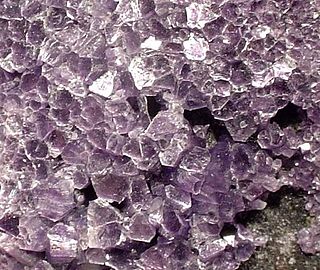
Amesite is a mineral with general formula of Mg2Al2SiO5(OH)4.
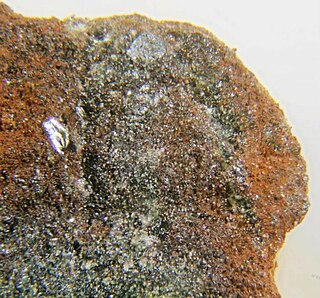
Minnesotaite is an iron silicate mineral with formula: (Fe2+,Mg)3Si4O10(OH)2. It crystallizes in the triclinic crystal system and occurs as fine needles and platelets with other silicates. It is isostructural with the pyrophyllite-talc mineral group.



















